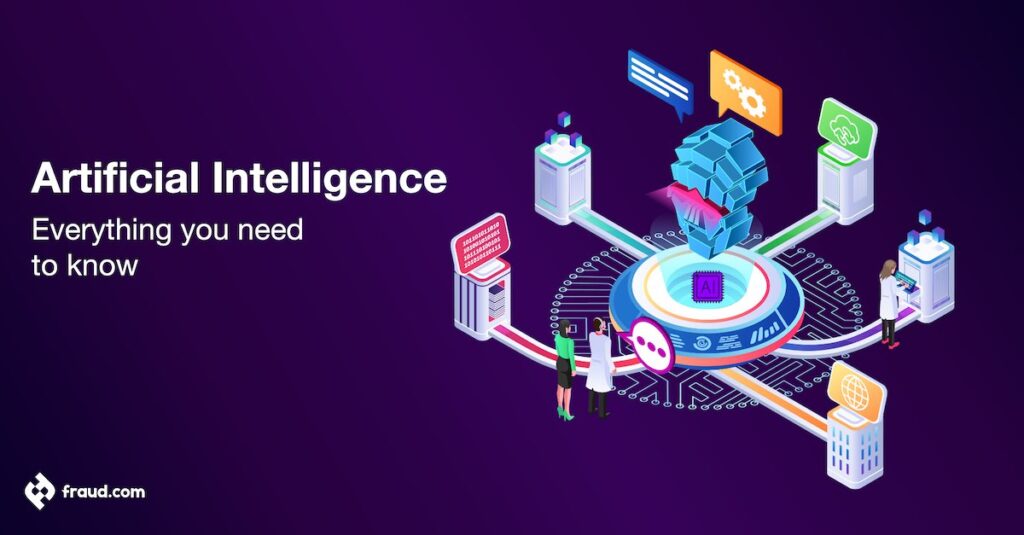“Can machines think?” This thought-provoking question has spurred debates, research, and technological advancements shaping much of our modern digital landscape.
Unanswered queries surrounding the cognitive capabilities of machines have slowly, yet perceptibly, inched closer to a resolution. Artificial intelligence (AI), a mysterious and promising technology, has greatly driven this evolution.
The fast growth of AI has caught the attention of decision-makers in the anti-fraud industry. This group knows how big of a change AI can make, not just in their industry, but in the whole world.
AI technology will revolutionise the fight against fraud, a problem that has troubled our systems for a long time. Rising to the challenges posed by fraud requires tools, strategies, and innovations on a scale that can only be furnished by disruptive technologies like AI.
The future is now. For those eager to navigate this exciting new landscape, understanding AI, its implications, its potential, and its trajectory is pivotal. This article is carefully made and contains valuable information about AI, serving as a complete guide.
Whether you’re a seasoned professional, a newcomer to the anti-fraud industry, or someone simply interested in the unfoldings in the AI field, this article aims to cater to your curiosity. By familiarising yourself with AI and its role in fraud detection and prevention, you are taking a significant stride towards securing and elevating your position in a rapidly evolving technological landscape.
Join us as we dive deep, unravelling the mysteries of AI together. This journey will be both educational and thrilling, potentially altering our view of future anti-fraud methods and our world.
Table of Contents
ToggleWhat’s Artificial Intelligence (AI)?
Artificial Intelligence (AI) is a branch of computer science dealing with the simulation of intelligent behaviour in computers. Essentially, AI is machine intelligence, framed on the idea that machines can mimic human intelligence— learning and problem solving. For instance, natural language processing (NLP), a subfield of AI, with its supervised learning approach, has transformed the way machines interact with humans.
In essence, AI offers a way for machines to carry out tasks that necessitate human intelligence – such as image recognition, decision-making, translating languages, and much more. AI is not limited to one algorithm or model. It includes many methods and tools that try to imitate or bring out aspects of human intelligence.
Put another way, AI can be seen as the art of imparting senses to machines, enabling them to perceive and apprehend the world in ways akin to human cognition, albeit within their programmed capabilities.
How does Artificial Intelligence work?
Understanding how Artificial Intelligence works can be complex, due to the variety of technologies and techniques it involves. Let’s break down the process into simpler, more manageable steps:
- Data collection: AI algorithms require massive amounts of data to learn from. This can include text, images, videos, and speech, among other forms of data.
- Data preprocessing: In this step, the collected data is cleaned and transformed into a usable format. Preprocessing could involve removing duplicate data, dealing with missing data points, or normalizing numerical values.
- Model selection: Depending on the problem at hand, a suitable AI model is chosen. It could range from a simple linear regression model to complex deep neural networks.
- Training the AI: Here the chosen models are trained using the preprocessed data. The AI learns patterns, relationships, and structures in the data.
- Testing the AI: Once trained, the AI is tested on new data, which it has not seen before. This step assesses how well the AI can generalize from its training.
- Deployment & predictions: If the AI performs well during the testing phase, it can be deployed to make predictions on real-world data. AI systems can provide valuable insights, recommendations, or autonomous actions based on these predictions.
- Continuous learning and updating: An integral aspect of AI is its ability to learn from new data constantly. The models are continuously updated as they gain more information or in response to changing environments.
The critical thing to remember is that AI doesn’t work in isolation. It’s typically part of a larger system, working in conjunction with other technologies to deliver results. AI’s true power lies in its capacity to continuously evolve, learn from its mistakes, and adapt to diverse scenarios.
History and evolution of Artificial Intelligence
Beginning as a mere idea in science fiction, the term artificial intelligence was introduced to the world at the Dartmouth Conference in 1956. Ever since AI has evolved, today’s large language models and deep neural networks stand as key milestones. Developments like machine learning and deep learning have become integral parts of AI and computer science.
In the 1960s and 1970s, AI research was primarily based on problem-solving methods and symbol manipulations. The field enjoyed considerable funding during these early years. However, the 1980s saw a decline in interest and investment as initial optimism gave way to the reality of AI’s limitations. The tide turned in the 1990s and 2000s with the rise of machine learning and deep learning, leading to breakthroughs in areas like data mining, natural language processing, and image recognition.
During this time, significant advancements in AI hardware acceleration technologies occurred. These advancements led to the development of high-performance processors that are specifically optimised for AI. These processors are now commonly used in the devices we have today. Moving into the 21st century, AI has become a fixture in everyday life, vastly surpassing its origins in science fiction, and proving that artificial intelligence is not just a fanciful concept but a transformative reality.
Types of Artificial Intelligence
AI can be divided into narrow AI, used in speech recognition, and general AI, designed for any intellectual task. Notably, machine learning, one of the types of artificial intelligence, is a subfield designed to help machines learn from unstructured data, moving towards predictive decision-making.
There’s no one-size-fits-all solution when it comes to AI. The types of AI vary enormously and depend on their capabilities and levels of technological advancement. A more in-depth classification sees AI divided into Reactive machines, Limited memory machines, Theory of mind, and Self-aware AI. But, for ease of understanding, let’s elaborate upon fundamental types and a few key subfields:
Types of AI based on capability:
- Narrow AI: Also known as Weak AI, this type fetches solutions for a specific task. It is designed and trained for a particular task, like voice assistance or facial recognition systems. Although smart in their field, these systems can’t outperform humans at tasks they weren’t trained for.
- General AI: These are the systems or machines which possess the ability to perform any intellectual task that a human being can do. They can understand, recognise, learn, and reason like humans, but currently, are more of conceptual and theoretical nature.
- Super AI: This type of AI exceeds human intelligence across most economically valuable work domains. Super AI is a hypothetical concept depicting AI’s future where machines will surpass human abilities and can perform tasks that are incomprehensible to humans.
Types of AI based on functionality:
- Reactive Machines: These are the most basic types of AI machines. They react to a given set of inputs with specific outputs, without the ability to form or learn from memories. A good example is IBM’s chess-playing supercomputer, Deep Blue, which defeated Garry Kasparov in the 1990s.
- Limited Memory: These machines have the ability to learn from historical data to make future decisions. For example, Self-driving cars gather data over time to improve their functioning and understand traffic behaviour.
- Theory of Mind: This AI type is a future concept where machines will supposedly understand and interpret emotions, beliefs, and thoughts, and interact socially like humans. These machines will have their own desires, beliefs, and intentions, which will influence the decision-making processes.
- Self-awareness: This is again a hypothetical concept for the future. Self-aware AI involves machines that have human-level consciousness and react in ways that indicate self-awareness. These machines will understand their internal states and predict the feelings of others.
Several evolving subfields of AI are proving to be game-changers in various industries:
- Machine Learning: An approach where machines are programmed to learn from data and improve their performance without being explicitly programmed. It is subdivided into Supervised Learning, Unsupervised Learning, and Reinforcement Learning.
- Deep Learning: A subset of machine learning, relying on neural networks with several layers – or ‘deep’ networks – to model and understand complex patterns.
- Natural Language Processing (NLP): It’s the combination of AI and linguistics that allows us to talk to machines as if they were humans.
- Computer Vision: It equips machines with the human-like capability to interpret and understand the visual world.
Understanding these types of AI helps in realising the vastness of AI’s potential and the trajectory it may adopt in the future.
Applications of Artificial Intelligence
AI technologies transcend sectors, from driving cars in navigation to real-time customer services. In healthcare, image recognition enhances diagnoses, while finance utilises AI for fraud detection. Thus, AI’s benefits range from precise problem-solving to automated routines.
In this digital age, the applications of AI are not only robust but also far-reaching. Enterprises across the globe are leveraging AI to optimise processes, enhance customer service, and generate predictive insights, among countless other uses. Below, we delve into more specific applications, spanning various industries and demonstrating the wide-ranging impact of AI:
Predictive Analysis: Utilising machine learning, businesses can accurately forecast customer behaviour, market fluctuations, and potential operational hitches, assisting strategic planning and decision-making.
Chatbots: Companies, especially within customer service, employ AI-powered chatbots for real-time, personalised interaction with users. They help automate tasks and provide quick responses.
Autonomous Vehicles: The automotive industry employs AI for its self-driving cars. AI technologies enable vehicles to navigate, perceive environments, and make data-driven decisions.
Fraud Detection: Especially within finance and insurance, AI helps detect irregular patterns and suspicious activities, providing real-time fraud detection and enhancing security.
Personalised Recommendations: Online retailers use AI for personalised marketing. Algorithms analyse customers’ shopping behaviours to deliver tailored suggestions.
Healthcare Diagnostics: AI algorithms can analyse extensive medical data such as scans, symptoms, and patient history to assist healthcare professionals in diagnosis and treatment.
Home Automation Systems: AI is powering smart home devices that automate lighting, security, entertainment systems, and temperature controls, among other features.
Content Creation: AI can generate insightful, data-driven content, particularly valuable for sectors like marketing and journalism.
Job and Candidate Screening: HR departments are utilising AI to streamline the recruitment process, screening thousands of job applications to find the most suited candidates.
In essence, AI has permeated virtually every sector, simplifying intricate operations, accelerating business growth, and improving the quality of services. These and many other applications are reshaping the competitive landscape and setting the precedent for a future driven by AI.
Benefits and challenges of Artificial Intelligence
As with any disruptive technology, AI brings plenty of promise, but not without its own set of obstacles and benefits. AI has many benefits, but there are also challenges and ethical issues that need to be discussed and addressed.
Benefits:
- Improved decision-making: AI’s ability to rapidly process and analyse big data means businesses can make informed decisions promptly.
- Increased efficiency: By automating repetitive tasks, AI allows humans to focus on complex problem-solving and creative tasks.
- Enhanced user experience: From personalised product recommendations to AI-powered chatbots, AI is elevating the customer experience.
- Cost savings: Whether through increased operational efficiency or deterring fraudulent activity, AI can lead to significant financial benefits.
- Predictive capabilities: AI’s ability to forecast trends and behaviours can prove to be a game-changer for many industries, particularly in fields like finance and healthcare.
Challenges:
- Job displacement: The fear of AI replacing human roles, particularly in sectors like manufacturing, is a primary concern.
- Data privacy: With AI’s ability to track and analyse personal data, concerns over privacy and data protection are significant.
- Bias in AI: If an AI system is trained on biased data, it can lead to unfair decisions and discrimination.
- Dependence on technology: Over-reliance on AI could make us complacent and overly dependent, possibly dampening our problem-solving and critical thinking abilities.
- Lack of transparency: Often referred to as “black box” AI, the inability of humans to understand how an AI system makes decisions can pose ethical and practical challenges.
In summary, although adopting AI may have difficulties and ethical issues, the advantages are much greater than the challenges. The key lies in proactive regulation, building robust ethical frameworks for AI, and continuous learning and adaptation as we step into the new era of AI.
Artificial Intelligence in Fraud Detection
Leveraging machine learning models, AI aids in fraud detection in near real-time. AI systems examine data, recognise patterns, and identify fraudulent transactions, thereby serving as a valuable tool for anti-fraud decision-makers.
Remember, this is just the tip of the iceberg. AI’s potential is boundless and continuously evolving. Journey with us as we venture into uncharted territories, unravelling the wonders of AI.
In the ever-evolving digital landscape, fraudsters are becoming increasingly sophisticated, making fraud detection a daunting task. The emergence of AI in fraud detection has proven to be a game-changer, offering not just increased accuracy but speed that no human could match.
- Identifying irregularities: AI systems can sift through vast amounts of data to identify irregularities or anomalies that could indicate fraudulent activity. They work 24/7, which is humanly impossible, catching suspicious activities in real-time or even forecasting them before they occur.
- Reducing false positives: Constant false alarms can cost a business time and resources. AI significantly decreases these instances by learning from past activities and refining its prediction models.
- Adaptive learning: Fraud detection techniques need to be dynamic, not static. AI adapts to new patterns of fraudulent activity, consistently learning and improving from each operation.
- User behaviour analytics: AI utilises deep learning to study user behavioural patterns, flagging any unusual or inconsistent behaviour. This is particularly useful in online platforms, where anomalous behaviour can give a quick red flag.
Challenges remain, primarily around data privacy and the sophistication of fraud schemes, but the contribution of AI to fraud detection is undeniably transformative. As we delve deeper into the AI labyrinth, the opportunities for disruption are limitless. Together, let us step into this brave, new world, where boundaries are continually pushed, and the impossible becomes achievable.
AI Fraud Detection by aiReflex
The fight against fraud in the digital world requires cutting-edge solutions. This is where aiReflex comes in, a pioneer in using the powerful combination of real-time analysis and explainable AI to safeguard transactions and ensure a seamless customer experience.
aiReflex possesses a multifaceted defence mechanism, capable of distinguishing between legitimate and fraudulent transactions as they occur. This real-time surveillance is key in preventing potential fraudulent activities without disrupting genuine transactions—significantly enhancing the customer experience.
How does it do this?
- Real-time analysis: By continuously monitoring transaction data, aiReflex can swiftly identify and halt suspicious activity. This proactive approach dramatically reduces the likelihood of fraud and enables immediate action.
- Multi-layer defence: aiReflex uses a comprehensive and layered approach to tackle the multiplicity and complexity of fraud. This approach ensures a robust defence, with each layer bringing its own strength to the battle against fraud.
- Explainable AI: One of the distinguishing features of aiReflex’s technology is its ability to provide clear and understandable reasoning behind its decisions. This transparency is critical for forming trust between aiReflex and its users, ensuring everyone involved understands how and why certain actions were taken.
- Improved customer experience: By sharply reducing false positives and streamlining the transaction process, aiReflex goes beyond defence to enhance the consumer journey. Customers get a seamless shopping experience, free from unnecessary interruptions due to mistaken fraud detection.
aiReflex stands at the forefront of the simultaneous fight against fraud and for brilliant customer experiences. Through advanced AI capabilities, aiReflex is transforming the way businesses approach fraud and reinforcing customers’ trust, one legitimate transaction at a time. As we embrace the AI-powered future, solutions like aiReflex guide the way, providing not just security but also transparency and value to all parties involved.









